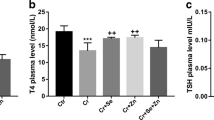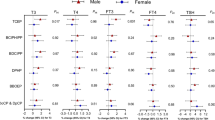Abstract
Considering the potential adverse effects of selenium and iodine deficiencies, and taking into account the widespread but often careless use of pyrethroid insecticides and their possible endocrine-disrupting effects, this study was undertaken to investigate the effects of fenvalerate on thyroid hormone parameters in both healthy and selenium- and/or iodine-deficient rats. Fenvalerate exposure had no effect on the TT4 levels of healthy controls but caused significant increases both in iodine deficiency (ID) and selenium plus iodine deficiency (ISeD), and a significant decrease in selenium deficiency (SeD). Dramatic increases in TT3 of all groups were observed by fenvalerate. Moreover, it caused insignificant decrease of thyroid stimulating hormone in healthy controls, no effect in SeD, and significant elevation in ID and ISeD. These results, thus, showed that the widely used pyrethroid insecticide fenvalerate has the potential to change significantly thyroid hormone parameters both in normal and deficiency states, and consequences of its thyroid status modifying effect might be of critical importance particularly in sensitive individuals and patients with thyroid dysfunction.



Similar content being viewed by others
References
Nussey SS, Whitehead SA (2007) The thyroid gland. In: Nussey SS, Whitehead SA (eds) Endocrinology: an integrated approach. Taylor & Francis, London, pp 71–111
Arthur JR, Beckett GJ (1999) Thyroid function. Br Med Bull 55:658–668
Larsen PR (1992) The thyroid. In: Wyngaarden JB, Smith LH, Bennett C (eds) Cecil textbook of medicine, 19th edn. WB Saunders Press, Philadelphia, pp 1248–1271
Zoeller RT (2007) Environmental chemicals impacting the thyroid: targets and consequences. Thyroid 17:811–817
Köhrle J, Jakob F, Contempré B, Dumont JE (2005) Selenium, the thyroid and the endocrine system. Endocr Rev 26:944–984
Vanderpas J (2006) Nutritional epidemiology and thyroid hormone metabolism. Annu Rev Nutr 26:293–322
Gentile F, Lauro R, Salvatore G (1995) Biosynthesis and secretion of thyroid hormones. In: DeGroot LJ (ed) Endocrinology. WB Saunders Press, Philadelphia, pp 517–542
Jameson JL, DeGroot LJ (1995) Mechanisms of thyroid hormone action. In: DeGroot LJ (ed) Endocrinology. WB Saunders Press, Philadelphia, pp 583–601
Köhrle J (2007) Thyroid hormone transporters in health and disease: advances in thyroid hormone deiodination. Best Pract Res Clin Endocrinol Metab 21:173–191
Beckett GJ, Peterson FE, Choudhury K et al (1991) Inter-relationships between selenium and thyroid hormone metabolism in the rat and man. J Trace Elem Electrolytes Health Dis 5:265–267
Vanderpas JB, Contempré B, Duale NL, Goossens W et al (1990) Iodine and selenium deficiency associated with cretinism in northern Zaire. Am J Clin Nutr 52:1087–1093
Casida JE, Quistad GB (1998) Golden age of insecticide research: past, present, or future? Annu Rev Entomol 43:1–16
Elliot M, Janes NF (1978) Synthetic pyrethroids—a new class of insecticide. Chem Soc Rev 7:473–480
Elliott M (1977) Synthetic pyrethroids. In: Eliot M (ed) American chemical society (ACS) symposium series, No 42. CRC Press, Washington DC, pp 229–232
Bradburry SP, Coast JR (1989) Comparative toxicology of the pyrethroid insecticides. Rev Environ Contam Toxicol 108:134–177
Maud SJ, Hamer MJ, Wariton JS (1998) Aquatic ecotoxicology of the pyrethroid insecticide lamdacyhalothrin: consideration for higher-tier aquatic risk assessment. Pest Sci 54:408–417
Mani U, Islam F, Prasad AK, Kumar P et al (2002) Stereidogenic alterations in testes and sera of rats exposed to formulated fenvalerate by inhalation. Human Exp Toxicol 21:593–597
Ecobichon JD (1991) The basic science of posions. In: Amdur MO, Doull J, Klassen CD (eds) Casarett and doulls toxicology. Macmillan Publishing Company, New York, pp 565–622
International Programme on Chemical Safety (1990) Environmental health criteria 95. Fenvalerate. World Health Organization, Geneva
Kaneko H, Ohkawa H, Miyamaoto J (1981) Comparative metabolism of fenvalerate and the 2S, aS isomer in rats and mice. Pest Sci 6:317–326
Dorman DC, Beasley VR (1991) Neurotoxicology of pyrethrin and the pyrethroid insecticides. Vet Hum Toxicol 33:238–243
Naharashi T (1986) Nerve membrane ionic channels as the target of toxicants. Arch Toxicol 9:3–13
Chen H, Xiao J, Hu G, Zhou J et al (2002) Estrogenicity of organophosphorus and pyrethroid pesticides. J Toxicol Environ Health Part A 65:1419–1435
Go V, Garey MS, Pogo BGT (1999) Estrogenic potential of certain compounds in the MCF-7 human breast carcinoma cell line. Environ Health Perspect 107:173–177
He J, Chen J, Liu R, Wang S et al (2004) Alterations of FSH-stimulated progesterone production and calcium homeostasis in primarily cultured human luteinizing-granulosa cells induced by fenvalerrate. Toxicology 203:61–68
Kim Y, Shin JH, Kim HS, Lee SJ et al (2004) Assessing estrogenic activity of pyrethroid insecticides using in vitro combination assay. J Reprod Dev 50:245–255
Kavlock RJ, Daston GP, DeRosa C, Fenner-Crisp P, Gray LE, Moore J et al (1996) Research needs for the risk assesment of health and environmental effects of endocrine disruptors. A report of the US EPA-sponsored workshop. Environ Health Perspect 104:715–740
Arena AC, Fernandez CD, Porto EM et al (2008) Fenvalerate, a pyrethroid insecticide, adversely affects sperm production and storage in male rats. J Toxicol Environ Health Part A 71:1550–1558
Kaul PP, Rastogi A, Hans RK et al (1996) Fenvalerate-induced alterations in circulatory thyroid hormones and calcium stores in rat brain. Toxicol Lett 89:29–33
Maiti PK, Kar A (1997) Dual role of testosterone in fenvalerate-treated mice with respect to thyroid function and lipid peroxidation. J Appl Toxicol 17:127–131
Maiti PK, Kar A, Gupta P, Chaurasia SS (1995) Loss of membrane integrity and inhibition of type-I iodothyronine 5′-monodeiodinase activity by fenvalerate in female mouse. Biochem Biophys Res Commun 214:905–909
Maiti PK, Kar A (1998) Is triiodothyronine capable of ameliorating pyrethroid-induced thyroid dysfunction and lipid peroxidation? J Appl Toxicol 18:125–128
Giray B, Riondel J, Richard M, Favier A, Hıncal F (2004) Oxidant/antioxidant status in relation to thyroid hormone metabolism in selenium-and/or iodine-deficient rats. J Trace Elem Exp Med 17:109–121
Schmutzler C, Gotthardt I, Hofmann PJ, Radovic B et al (2007) Endocrine disruptors and the thyroid gland—a combined in vitro and in vivo analysis of potential new biomarkers. Environ Health Perspect 115:77–83
Bogazzi F, Raggi F, Ultimieri F, Russo D et al (2003) Effects of a mixture of polychlorinated biphenyls (Aroclor 1254) on the transcriptional activity of thyroid hormone receptor. J Endocrinol Investig 26:972–978
Santini F, Vitti P, Ceccarini G, Mammoli C et al (2003) In vitro assay of thyroid disruptors affecting TSH-stimulated adenylate cyclase activity. J Endocrinol Investig 26:950–955
Schmutzler C, Hamann I, Hofmann PJ, Kovacs G et al (2004) Endocrine active compounds affect thyrotropin and thyroid hormone levels in serum as well as endpoints of thyroid hormone action in liver, heart and kidney. Toxicology 205:95–102
Schmutzler C, Bacinski A, Ambrugger P, Huhne K et al (2006) Thyroid hormone biosynthesis is a sensitive target for the action of endocrine disrupting chemicals. Exp Clin Endocrinol Diabetes 114:S14
Yamauchi K, Ishihara A, Fukazawa H, Terao Y (2003) Competitive interactions of chlorinated phenol compounds with 3, 3′, 5-triiodothyronine binding to transthyretin: detection of possible thyroid-disrupting chemicals in environmental waste water. Toxicol Appl Pharmacol 187:110–117
Clementi M, Tiboni GM, Causin R et al (2008) Pesticides and fertility: an epidemiological study in Northeast Italy and review of the literature. Reprod Toxicol 26:13–18
Meeker JD, Barr DB, Hauser R (2008) Human semen quality and sperm DNA damage in relation to urinary metabolites of pyrethroid insecticides. Hum Reprod 23:1932–1940
Roeleveld N, Bretveld R (2008) The impact of pesticides on male fertility. Curr Opin Obstet Gynecol 20:229–233
Wang S, Shi N, Ji Z, Pinna G (2002) Effects of pyrethroids on the concentrations of thyroid hormones in the rat serum and brain. Zhonghua Lao Dong Wei Sheng Zhi Ye Bing Za Zhi 20:173–176
Akhtar N, Kayani SA, Ahmad MM, Shahab M (1996) Insecticide-induced changes in secretory activity of the thyroid gland in rats. J Appl Toxicol 16:397–400
Liu P, Song X, Yuan W et al (2006) Effects of cypermethrin and methyl parathion mixtures on hormone levels and immune functions in wistar rats. Arch Toxicol 80:449–457
Jahnke GD, Choksi NY, Moore JA, Shelby MD (2004) Thyroid toxicants: assessing reproductive health effects. Environ Health Perspect 112:363–368
Author information
Authors and Affiliations
Corresponding authors
Rights and permissions
About this article
Cite this article
Giray, B., Cağlayan, A., Erkekoğlu, P. et al. Fenvalerate Exposure Alters Thyroid Hormone Status in Selenium- and/or Iodine-Deficient Rats. Biol Trace Elem Res 135, 233–241 (2010). https://doi.org/10.1007/s12011-009-8506-7
Received:
Accepted:
Published:
Issue Date:
DOI: https://doi.org/10.1007/s12011-009-8506-7




